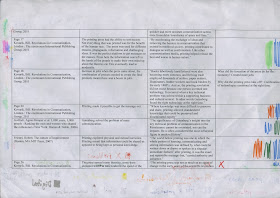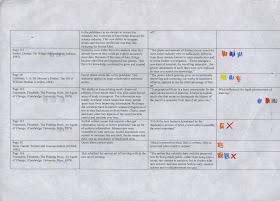Mark
Edwards - DR. ME
Edwards,
M. 2013. Why is letterpress relevant to 21st century graphic designers?.
Interviewed by Joshua Douglas. Leeds College of Art, 28/11/2013.
1.
Have you ever used letterpress for one of your briefs at DR ME? If so, what was
the project about and what was your reasoning for choosing this printing
method?
One of the first things we ever did
together was create the sleeve artwork for a local record label called Across
the Pennines, on at least one of the sleeves we used letterpress to create the
track listing, it was mainly because we had access to the letterpress at our
university and our tutor showed us a great deal of his work that was letter
pressed and it left a real impression on us.
2.
In a largely digital world, how relevant do you think letterpress is to graphic
design in the 21st Century? And do you think there is a future for the
tradition?
It holds the imperfections and cracks
that digital type will never be able to realistically replicate therefore it is
incredibly relevant to graphic design right now. As with everything it will
suffer for a few more years until people become bored of seeing the same kind
of design created and yearn for something more tactile and exciting.
3.
How do you think graphic designers of the 21st century can benefit from
learning letterpress?
It gives you a better understanding of
how to use type so I'd say absolutely yes!
4.
In your opinion what was the most significant impact the printing press had on
society? And what role do you think it plays in today's world?
Gonna have to think on that one bro
The Beautiful Meme
Woolley, M. 2013. Why is letterpress relevant to 21st century
graphic designers?. Interviewed by Joshua Douglas. Leeds College of Art,
17/12/2013.
1.
Have you ever used letterpress for one of your briefs at The beautiful Meme If so, what was the
project about and what was your reasoning for choosing this printing method?
Yes we used it for creating the
Parallel invites we did. We used letterpress because we were creating a bespoke
invite on thick card. Wouldn't of been able to put it through a litho machine
or most digital presses so the only alternative was screen printing or
letterpress. Screen printing can some times give of a loose, messy look if not
done right, so the letter press was the best option as it gave a clinical neat
feel and also gave a bit of a texture to type (embossed).
2.
In a largely digital world, how relevant do you think letterpress is to graphic
design in the 21st Century? Do you think there is a future for the tradition?
The key word here is tradition, it will
always be used by a few, may rise in popularity then die down again but it will
never be forgotten, much like vinyl. It has an aura to it, everything from the
smell of ink to the process to the finished article. I wouldn't say it has a
future as such because it not ground breaking nor will change the world but it
will create an aura that people will latch on to. I think it has a purpose when
used for the right job. I mean I cant see a company like Apple using it but for
more bespoke jobs I can see it has a value.
3.
Do you think designers of the 21st century can benefit from learning
letterpress? If so in what way will it help their practice?
I think it would help their overall
knowledge of graphic design and could inspire ideas. Really though I think it's
just an excuse to get messy and get off the computer which is fun. I suppose
though it can teach you many things. I mean watching Nick at print project
really inspired me to better at my craft in terms of being a designer but it
didn't make me go " right I’m gonna letterpress the fuck out of
everything". When it's appropriate use it. When it's not don't. (Or
sometimes do, but be clever about it.)
4.
In your opinion what was the most significant impact the printing press had on
society? And what role do you think it plays in today's world?
Well it changed the world really. It
made information, art and news accessible to the world, much like the Internet
is doing now. What ever is cheaper and faster to produce in the end, is going
to rule the world. I mean I'd love it if every piece of print I picked up was a
crafted bespoke delight, but how long would it take me to actually get a
newspaper or how much would that book I've wanted to get for ages cost and will
that client be happy about paying an extra shed load of cash for a flyer. In
this day and age it all comes down to speed and cost in terms of production for
most.
Printing changed the
world, I personally think it's time to move on, but I still do love (and always
will do) an edition screen print or a letter pressed business card because I
understand the craft that goes into them, the slight imperfections resemble a
human like characteristic as opposed to a digital soulless press.
Chris Jackson – Elmwood
Jackson, C. 2013. Why is letterpress relevant to 21st
century graphic designers?. Interviewed by Joshua Douglas. Leeds College of
Art, 18/12/2013.
Firstly it is important
for me that we put the questions into context, Letterpress is just a method of
printing. I do not believe I can be held as an idea in its own right, you can
certainly appreciate the aesthetics of it and it can certainly reinforce a
message or thought and give stylistic help but it is at the end of the day a
production tool and no different from building a website or hosting an event,
what matters is 'how do I get my idea across in the most interesting and
relevant way'.
1. Have you ever used letterpress for one of your briefs at
Elmwood? If so, what was the project about and what was your reasoning for
choosing this printing method?
I haven't used letterpress;
I think the closest I have come to using more traditional methods is probably
foil blocking which I have used on quite a few projects both at Elmwood and
previous agencies. Mainly stationery and a couple of promotional posters, I
used it just for the effect.
2. In a largely digital world, how relevant do you think
letterpress is to graphic design in the 21st Century? Do you think there is a
future for the tradition?
Of course, this is the
traditional End of print question, it won't die off it will just evolve, look
at one of the most copied and iconic (whether you like it or not) pieces of
design over the past few years, Anthony Burrills work hard and be nice to people
poster, he must be a millionaire of the back of that. Or look at the career of
Alan Kitching he is still doing modern, interesting work. The future will come
from designers wanting that very specific look and feel that letterpress gives,
and using it in new and different ways.
3. Do you think designers of the 21st century can benefit from
learning letterpress? If so in what way will it help their practice?
I think that depends on
the designer, there are certain skills that would be valuable like core typography
skills (kerning etc). But for me I am interested in collaboration why would I
learn to do it (and maybe not be able to do it very well, when I can work with
and learn from the best letterpress artist and get them to create something for
me and my client which will end up being a much richer and far more interesting
project.
4. In your opinion what was the most significant impact the
printing press had on society? And what role do you think it plays in today's
world?






























